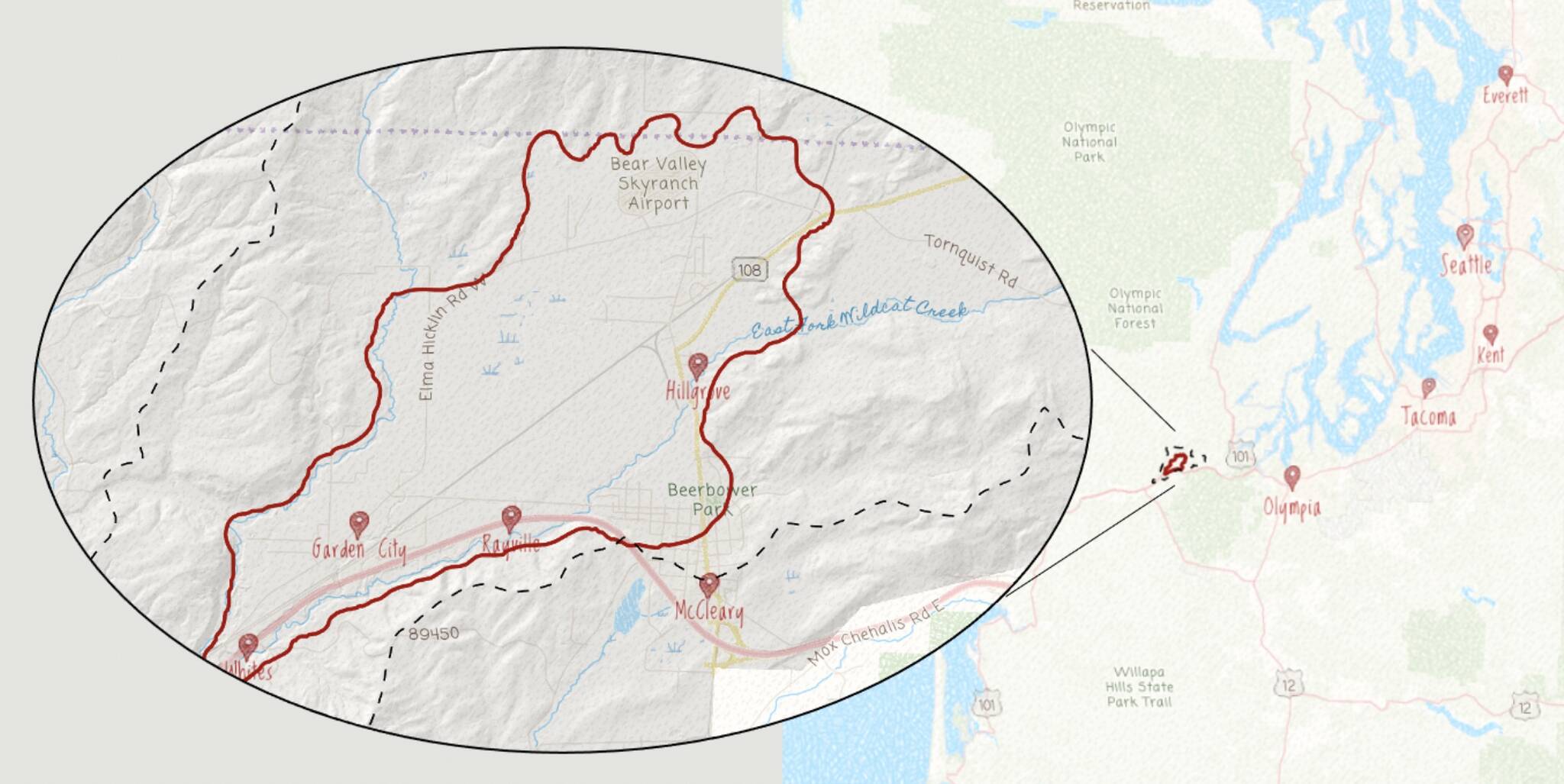The porous soils below the earth’s surface in East Grays Harbor County deposited by glaciers roughly 100,000 years ago have piqued the interest of the people who live on top of them.
Water cupped within the soil’s pores, specifically, and whether or not it can sustain a growing population, is the subject in question.
That water, the Wildcat Creek aquifer, provides the city of McCleary, as well as the surrounding area, with its water supply. But the aquifer is unique in structure, its resource potentially finite, leading city officials to instigate an ongoing study of the subterranean supply as proposals for new development continue to dot the area.
The city last fall employed consultant EA Engineering, Science and Technology Inc. to examine the current nature of the aquifer and develop a plan for future use, including goals necessary for sustainability of the water supply.
While previous studies have examined the Wildcat aquifer, no formal investigations had been recently conducted, said Chad Bedlington, public works director for the city of McCleary.
The aquifer serves city needs and private wells. Bedlington said the city serves 859 water customers with the aquifer.
“It was brought forward that as potential development occurs in areas above the aquifer recharge area, there was really no understanding of what impact that might have,” Bedlington said.
The plan will “provide a roadmap for groundwater use and management that can be maintained in a manner over a 20-year horizon without causing undesirable results,” according to the plan’s website.
Bedlington said one proposed development in particular — a 40-acre annexation north of town — led city officials to request the study. The McCleary city council rejected the proposal, which was proposed for property owned by Port Blakely Tree Farms and would’ve paved the way for a significant housing development.
The city now waits for the results from the Aquifer Sustainability Plan, which could be ready by April or May, Bedlington said.
Much of the information for the study is still “preliminary,” according to Maria Daugherty, a geologist with EA Engineering. The group has been gathering data from past studies while compiling satellite imagery that will eventually make up a final document for the city’s review.
Based on existing information about the aquifer, Daugherty said, there is likely a recharge area — where the aquifer gets refilled — in the northeast portion of the aquifer’s basin. Aquifers refill when gravity drains water, mostly from precipitation, through layers of soil. Finding out more about the rate and mechanism of recharge will help indicate the level of use the aquifer can sustain, Daugherty said.
What Daugherty does know, based on over 200 well logs from the area, is that at least part of the aquifer resides beneath a layer of till, a glacial remnant. Water can’t pass through till as easily as other sedimentary layers, Daugherty said, making recharge a slower process. However, till’s more impervious nature scrubs water clean of contaminants, making the layer beneficial for water quality, Daugherty said. Bedlington said regular tests from the city show the aquifer produces high quality water.
But perhaps the more pertinent quality of Wildcat aquifer for the city and stakeholders is its isolation. Wildcat aquifer is a “sole source” aquifer, meaning it’s disconnected from other aquifers or groundwater sources.
That’s an important factor for Marina Kuran, a member of the Aquifer Sustainability Planning Board, and whose well draws from the Wildcat aquifer. Kuran recognized that residential growth will lead to limited water availability, and said she hopes the current study will provide enough information to designate the Wildcat aquifer as a federal sole source aquifer through the Environmental Protection Agency.
“If it has that recognition, it’s going to get that kind of protection,” Kuran said.
Daugherty said other community stakeholders had recognized the significance of the aquifer’s isolation.
“I think one major component of this research is that, at least from the stakeholder perspective, is that we only have one aquifer, and we need to make sure it’s taken care of,” Daugherty said.
Once EA provides the sustainability plan to the city, the group will also apply for grants to fund projects to improve water quality and supply in the Wildcat Basin.
For Kirsten Harma, watershed coordinator with the Chehalis Basin Partnership, the Wildcat Basin is an area of particular interest. As part of Washington’s 2018 Streamflow Restoration Act, the partnership identifies projects in the Chehalis Basin that could improve streamflow to offset water withdrawn by Permit-Exempt Wells, which withdraw less than 5,000 gallons per day.
Based on the partnership’s forecast for Permit-Exempt Wells, an area that includes Wildcat Basin could see 150 to 300 new wells by 2040. The influx of wells means the partnership could potentially step in and instigate streamflow projects that would offset the water lost in the basin. Projects could also focus on retaining water in the basin for when flows are low, Harma said.
Daugherty said it’s unclear at this point, however, if streamflows from Wildcat Creek have much of a bearing on or relationship with the status of the Wildcat aquifer.
Once the sustainability plan is complete, the council will have a chance to review it, as will the public, likely through public hearings, Bedlington said. According to the plan’s technical proposal, GIS data from the study will be compiled into a database and provided to the city.
“If the city decides to release this GIS data to the public, it will increase transparency among stakeholders in the watershed and allow for others to build upon this work,” the technical proposal reads.
For more information on the Aquifer Sustainability Plan, visit https://city-of-mccleary-aquifer-sustainability-plan-usaquifers.hub.arcgis.com/pages/75a956a16fbf4de29a0d608058cc2272.
Contact reporter Clayton Franke 406-552-3917 or clayton.franke@thedailyworld.com.


